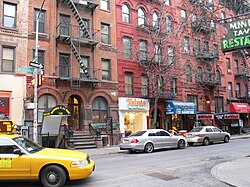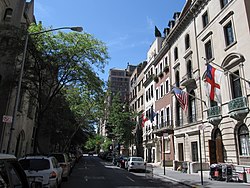Main article: Architecture of New York City
See also: List of skyscrapers in New York City
A. T. Stewart in 1870, 9th Street, Manhattan
Numerous buildings have a jagged façade, exemplified at Park Avenue and 57th Street in Midtown Manhattan
Architectural history
The skyscraper, which has shaped Manhattan's distinctive skyline, has been closely associated with New York City's identity since the end of the 19th century. From 1890 to 1973, the title of world's tallest building resided continually in Manhattan (with a gap between 1901 and 1908, when the title was held by Philadelphia City Hall), with nine different buildings holding the title.[168] The New York World Building on Park Row, was the first to take the title in 1890, standing 309 feet (94 m) until 1955, when it was demolished to construct a new ramp to the Brooklyn Bridge.[169] The nearby Park Row Building, with its 29 stories standing 391 feet (119 m) high took the title in 1899.[170] The 41-story Singer Building, constructed in 1908 as the headquarters of the eponymous sewing machine manufacturer, stood 612 feet (187 m) high until 1967, when it became the tallest building ever demolished.[171] The Metropolitan Life Insurance Company Tower, standing 700 feet (210 m) at the foot of Madison Avenue, wrested the title in 1909, with a tower reminiscent of St Mark's Campanile in Venice.[172] The Woolworth Building, and its distinctive Gothic architecture, took the title in 1913, topping off at 792 feet (241 m).[173] Structures such as the Equitable Building of 1915, which rises vertically forty stories from the sidewalk, prompted the passage of the 1916 Zoning Resolution, requiring new buildings to withdraw progressively at a defined angle from the street as they rose, in order to preserve a view of the sky at street level.The Roaring Twenties saw a race to the sky, with three separate buildings pursuing the world's tallest title in the span of a year. As the stock market soared in the days before the Wall Street Crash of 1929, two developers publicly competed for the crown.[174] At 927 feet (283 m), 40 Wall Street, completed in May 1930 in only eleven months as the headquarters of the Bank of Manhattan, seemed to have secured the title.[175] At Lexington Avenue and 42nd Street, auto executive Walter Chrysler and his architect William Van Alen developed plans to build the structure's trademark 185-foot (56 m) spire in secret, pushing the Chrysler Building to 1,046 feet (319 m) and making it the tallest in the world when it was completed in 1929.[176] Both buildings were soon surpassed with the May 1931 completion of the 102-story Empire State Building with its Art Deco tower reaching 1,250 feet (380 m) at the top of the building. The 203-foot (62 m) high pinnacle was later added bringing the total height of the building to 1,453 ft (443 m).[177][178]
The former Twin Towers of the World Trade Center were located in Lower Manhattan. At 1,368 and 1,362 feet (417 and 415 m), the 110-story buildings were the world's tallest from 1972 until they were surpassed by the construction of the Willis Tower in 1974 (formerly known as the Sears Tower, located in Chicago).[179] One World Trade Center, a replacement for the Twin Towers of the World Trade Center, is currently the tallest building in the Western Hemisphere.[180]
In 1961, the Pennsylvania Railroad unveiled plans to tear down the old Penn Station and replace it with a new Madison Square Garden and office building complex. Organized protests were aimed at preserving the McKim, Mead & White-designed structure completed in 1910, widely considered a masterpiece of the Beaux-Arts style and one of the architectural jewels of New York City.[181] Despite these efforts, demolition of the structure began in October 1963. The loss of Penn Station—called "an act of irresponsible public vandalism" by historian Lewis Mumford—led directly to the enactment in 1965 of a local law establishing the New York City Landmarks Preservation Commission, which is responsible for preserving the "city's historic, aesthetic, and cultural heritage".[182] The historic preservation movement triggered by Penn Station's demise has been credited with the retention of some one million structures nationwide, including nearly 1,000 in New York City.[183]
Parkland
17.8% of the borough, a total of 2,686 acres (10.87 km2), is devoted to parkland. Almost 70% of Manhattan's space devoted to parks is located outside of Central Park, including 204 playgrounds, 251 Greenstreets, 371 basketball courts and many other amenities.[184]Central Park is bordered on the north by West 110th Street, on the west by Eighth Avenue, on the south by West 59th Street, and on the east by Fifth Avenue. Along the park's borders, these streets are usually referred to as Central Park North, Central Park West, and Central Park South, respectively (Fifth Avenue retains its name along the eastern border). The park was designed by Frederick Law Olmsted and Calvert Vaux. The 843-acre (3.41 km2) park offers extensive walking tracks, two ice-skating rinks, a wildlife sanctuary, and grassy areas used for various sporting pursuits, as well as playgrounds for children. The park is a popular oasis for migrating birds, and thus is popular with bird watchers. The 6-mile (9.7 km) road circling the park is popular with joggers, bicyclists and inline skaters, especially on weekends and in the evenings after 7:00 pm, when automobile traffic is banned.[185] While much of the park looks natural, it is almost entirely landscaped and contains several artificial lakes. The construction of Central Park in the 1850s was one of the era's most massive public works projects. Some 20,000 workers crafted the topography to create the English-style pastoral landscape Olmsted and Vaux sought to create. Workers moved nearly 3,000,000 cubic yards (2,300,000 m3) of soil and planted more than 270,000 trees and shrubs.[186]
The African Burial Ground National Monument at Duane Street preserves a site containing the remains of over 400 Africans buried during the 17th and 18th centuries. The remains were found in 1991 during the construction of the Foley Square Federal Office Building.













